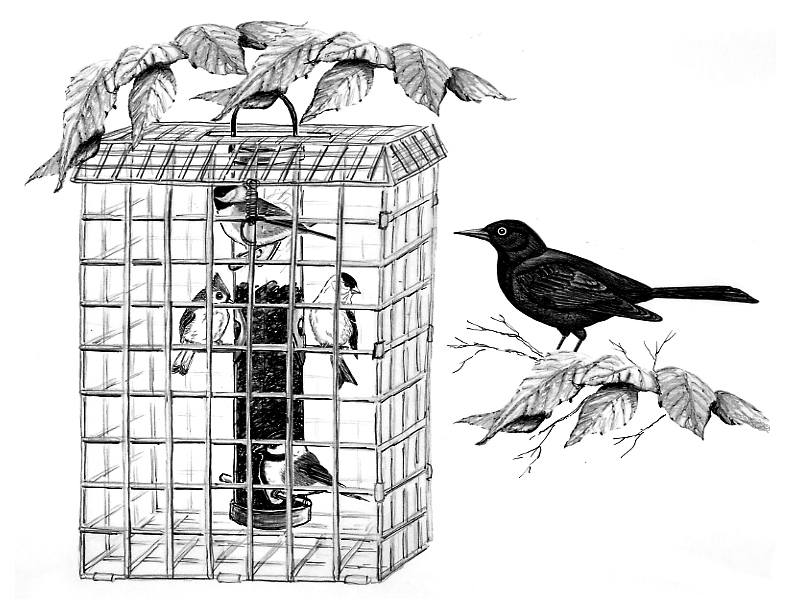
Dear Bird Folks,
I had hoped to ask you this question in person, but with face-to-face conversations being limited right now, I’m writing to you instead. What can I do to “grackle-proof” my bird feeder. They keep cleaning me out.
– Neil, Truro, MA
I agree, Neil,
Ever since early March, when we were all advised, at least at the local level, to take this awful virus seriously, communication with customers has been limited. As is the case with most small shops, we specialize in back and forth banter with all who stop by. But when the shutdown was announced and we were limited to “parking lot service” only, making normal conversation became tricky. Between the sounds of the wind and the traffic, plus the masks, which causes everyone to sound like a kidnap victim, we can hardly understand the simplest inquiries. The most commonly asked questions this summer are “What?” followed by, “Huh?” I’m glad you wrote instead.
When it comes to the backyard, grackles are the avian equivalent of the gray squirrel. Grackles eat a lot of birdseed, are relentless and, according to many of my customers, scare away all the “good birds.” That phrase makes me laugh. I say any bird that eats lots of birdseed is a good bird.
North America has three species of grackles. Folks who spend time in Florida are familiar with Boat-tailed Grackles, while the Southwestern states lay claim to Great-tailed Grackles. Here in New England we are blessed with the Common Grackle, with “common” being an accurate description…or at least it was. Back in the early 1970s, the Common Grackle population was thought to be nearly 190 million birds, but ever since then their numbers have started to slide, a lot. There are now significantly fewer grackles than we had forty-five years ago. Part of the decline has to do with habitat changes. Many of the birds’ favorite fields have been reclaimed by forests. Having more forests doesn’t seem so bad, but the other reason for the lower number is a little more sinister. As we all know, grackles are quick to take advantage of any available food source, and when the food source also happens to be a farmer’s crops, the birds face lethal measures. Today, the grackle population has dwindled to 70 million birds, which is still a lot and at times it seems most of them are in my yard.
What can you do to limit the number of grackles on your feeder? Well, the first thing most people do is bang on their windows and yell like an idiot. But that only gains temporary results, plus they look like an idiot. The cheapest and easiest thing to do is to fill your feeder with safflower seed. Safflower is a hard white seed that grackles tend not to eat. I suggest buying enough safflower to refill the feeder several times before evaluating its success. Not everyone has great results, but it’s worth a try. FYI: We sell close to a ton of safflower seed every week, so it is clearly working for some people. Keep in mind that safflower isn’t a repellent, so don’t mix it with any other seed, or the grackles will ignore the safflower and chow on the other seed. I can’t believe I have to remind people of that, but I do, all the time.
If safflower doesn’t work, the next step is to buy a new feeder. Some bird feeders allow you to adjust the carrying capacity of the perches. You can set the feeder to close down when something heavy (grackle) lands on the perch. This seems like a good solution and it is, sort of. Once again, like squirrels, grackles are resourceful and will sometimes still get a little seed anyhow. This doesn’t bother some people. They figure if the bird has to work that hard for its lunch, it can have a little bit. Then there are the people who can’t stand the thought of grackles eating any of their seed whatsoever. These are people who also bang on the window like idiots. For these people, we have the cage feeders. I like cage feeders because they will not only stop the grackles, they will also stop people from banging on windows. There’s just one problem with the cages. What is it? You’ll see.
Cage-style feeders are basically what they sound like: the feeder sits inside a wire cage, preventing the grackles from reaching the seed. Keep in mind that not all feeder/cage combinations are created equal. The cage needs to separate the feeder by at least four inches or the grackles, which seem to have necks like giraffes, will be able to stretch and get to the food. I use a cage setup this time of year and have no problem with grackles. It sounds like a perfect solution, but here’s the downside: only smaller birds are able to squeeze through the wire. That means in addition to grackles, the cage will also keep out…cardinals. Oh, no! Whenever I mention that last piece of information to a customer, he or she (usually she) will turn pale, like I’ve presented her with a bird version of Sophie’s Choice. I remind her that the cardinals will still come; they will just have to eat off the ground. But that’s like telling a dog owner (in the year 2020) that their dog has to sleep on the floor, instead of the furniture. It’s not an acceptable option.
When it comes to dealing with grackles, Neil, the first thing to try is safflower seed. If you give it a fair try (a few weeks) and aren’t happy with the results, switch to a cage feeder. If you have any more questions on this topic, you’ll have to come see me in person. I’ll be the one in the parking lot asking, “What?” followed by, “Huh?”